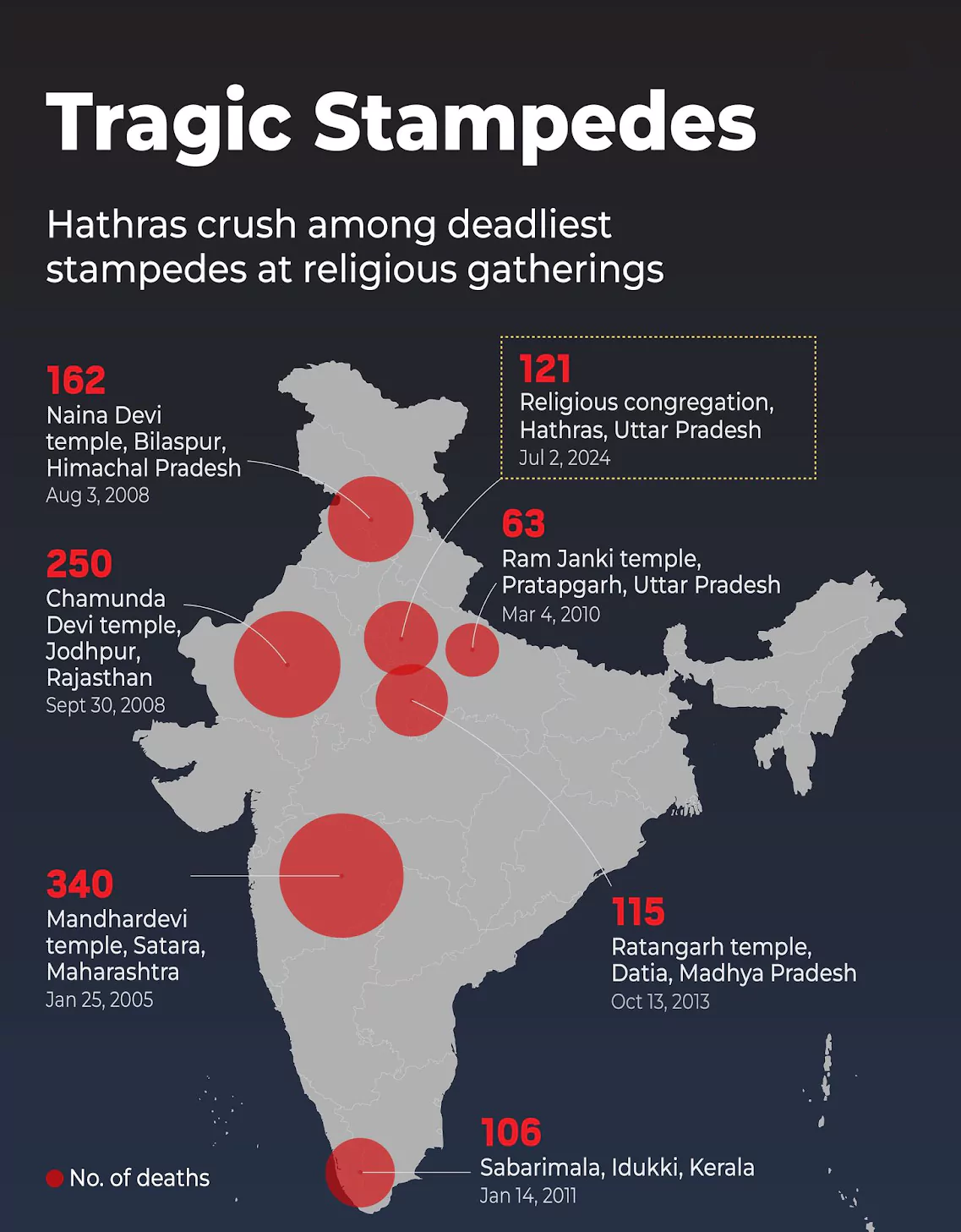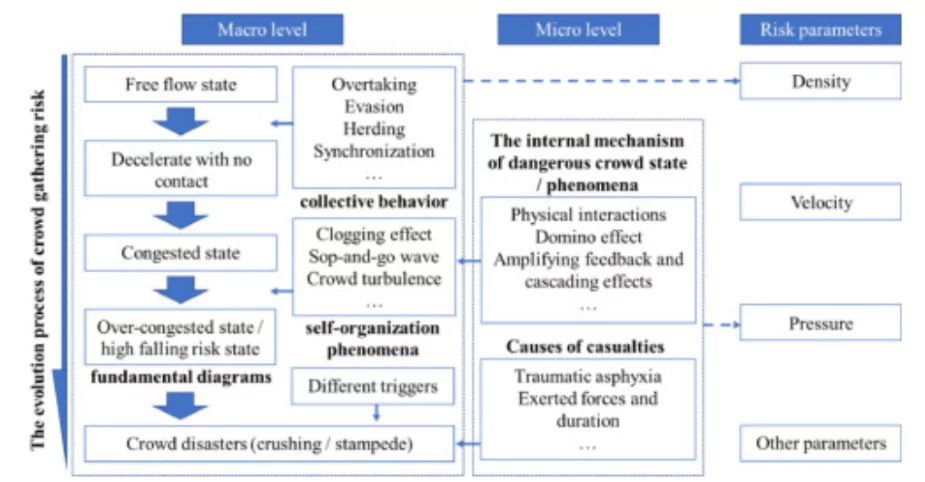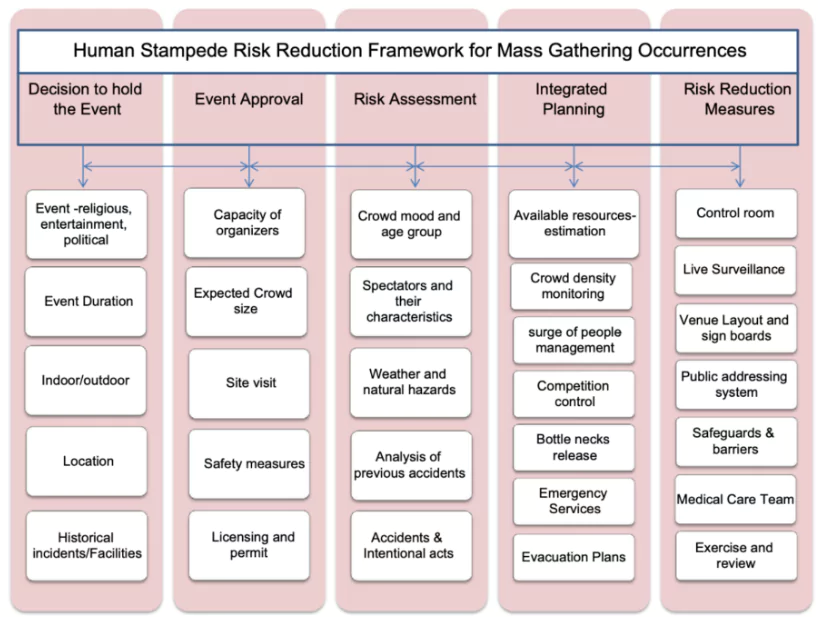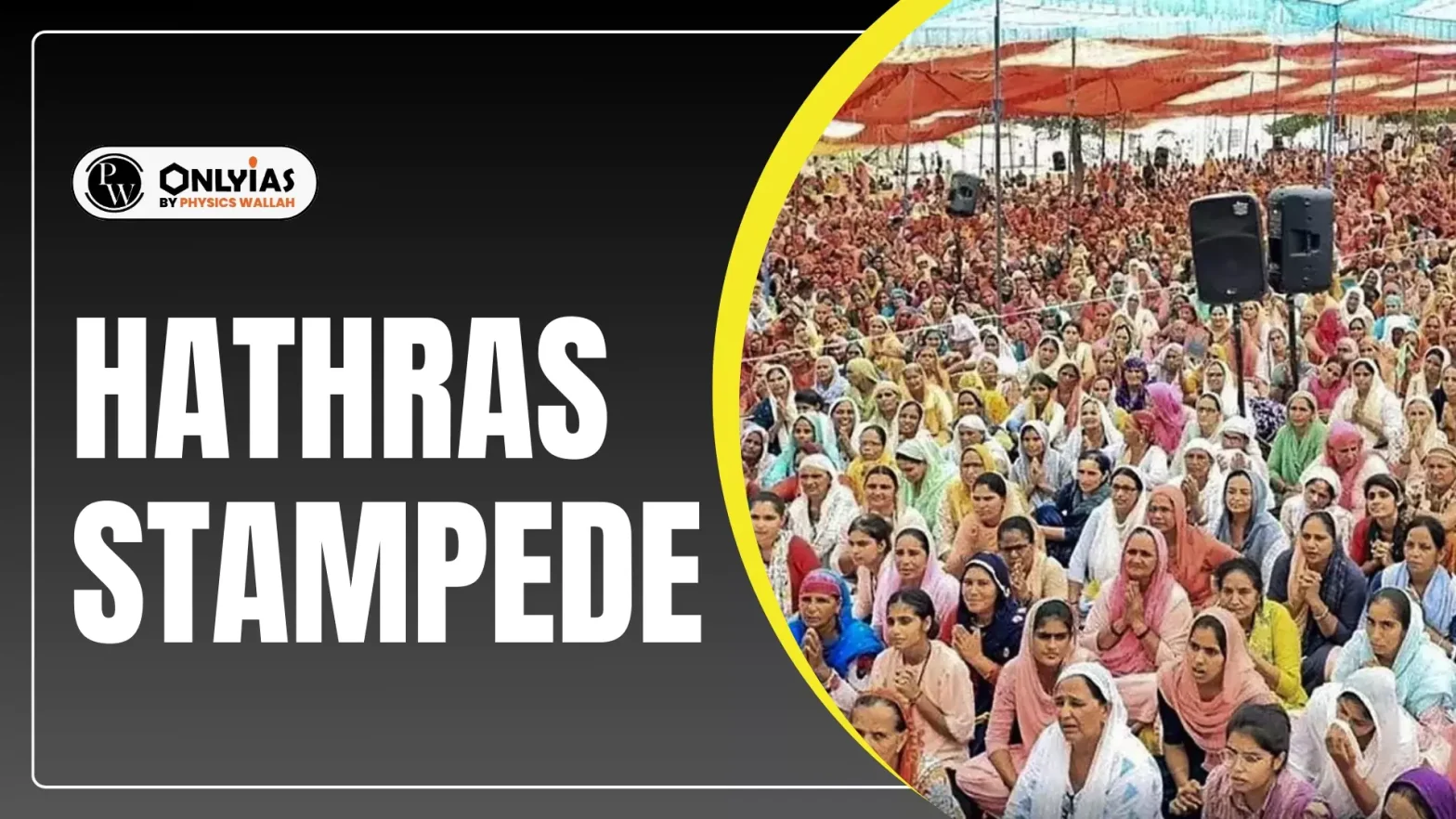A stampede at a religious gathering in Uttar Pradesh’s Hathras district costed at least 121 lives, almost all women recently.
About Stampedes
- A stampede can be described as the impulsive mass movement of a crowd or disruption of their orderly movement leading to injuries and fatalities, often in response to a perceived danger, loss of physical space or a will to attain something seen as gratifying.
 As per the National Crime Records Bureau figures, from 2000 to 2013, India witnessed almost 2,000 deaths resulting from stampedes.
As per the National Crime Records Bureau figures, from 2000 to 2013, India witnessed almost 2,000 deaths resulting from stampedes.
- Causes:
- Mass Gatherings: These are almost always the cause for stampedes either spontaneous, or planned ones, which are either triggered or made worse by panic.
- Religious Mass Gatherings: According to a study conducted in 2013, 79% of all stampedes in India from 1954-2012 took place in religious mass gatherings
- Inadequate physical organisation of spaces: The paper “Stampede Events and Strategies for Crowd Management” (2018) by Chun-Hao Shao lists a number of physical factors which can lead to a stampede like situation.
- Lack of light; Crowd flow not being divided for different crowds; Collapse of barriers, buildings; Blocked exits, evacuation route; Poor design of hardware (such as a revolving door at the entrance); Fire hazards; narrow spaces; overcapacity.
Enroll now for UPSC Online Course
- Types: Stampedes can be classified into two types on the basis of movement ie. unidirectional or turbulent
- Unidirectional stampede: This event may occur when a crowd moving in the same direction encounters a sudden positive or negative change in force which alters its movement.
- A positive force can be a “sudden stop” situation like a bottleneck and blocked exit.
- A negative force would be something like a broken barrier or column which sends a group of people tumbling.
- Turbulent stampede: This event can occur in situations with uncontrolled crowds, induced panic, or crowds merging from numerous directions.
- Psychology of Stampedes:
- The ‘Craze’ Behaviour: Craze is defined by sociologist Neil J Smelser In Theory of Collective Behavior (1962), as “the mobilisation for action based on a positive wish-fulfillment belief” which can be rational or irrational.
- Example: In Hathras satsang (large group settings), The people rushed to touch the preacher’s feet and tried to collect soil from beneath his feet, making people act in detriment to their own individual interests.
- Psychology of Mass Behaviour: Psychologist Alexander Mintz theorised that once the cooperative pattern of behavior is disturbed in panic-producing situations, cooperation ceases to be rewarding to the individuals self interest causing further panic.
- Example: Taking the example of a fire emergency in a movie theatre, Mintz argued that pushing to escape a disaster becomes an advantageous (rather least disadvantageous) form of behaviour for individuals, but at the level of the group, it can lead to disastrous circumstances.
- Crowd Density (number of people per unit of area): As per a study, when the density approached 3 and 4 persons/ sq m, most cases spent over 8 min in evacuation.
- If evacuees spend too much time waiting for evacuation or are blocked near the exit, crowd panic will increase, as will stampede risk.
- The Black Hole Phenomenon: The phenomenon is being described by Helbing in a 2014 paper in the Journal of Statistical Physics.
- Force Chains: As per it, the contact between people’s bodies in a tightly packed environment causes physical forces to be transmitted from one individual to another which may add up and create unpredictable “force chains” pushing the individuals from various directions.
- Black Hole: Eventually, the pushes may reach to a level that can cause one or more individuals to stumble and fall, creating a “hole” in the crowd breaking the balance of forces. The surrounding crowd is still being pushed from behind, but no longer from the front because of the “hole” leading to more stumbling and falling.

- How Stampedes Lead to death:
- Traumatic Asphyxia: It is a condition of partial or complete cessation of respiration due to external compression of the thorax and/or upper abdomen.
- Even moderate crowds of six to seven people pushing in one direction can result in a significant compression force, enough to hurt and kill humans.
- Myocardial infarction: Heart attack, caused by decreased or complete cessation of blood flow to a portion of the heart
- Other causes: Direct crushing injury to internal organs, head injuries, and neck compression.
 Impacts:
Impacts: -
- Trauma and Shocks: Stampedes can cause immense trauma for the family and friends of the victims, as a feeling of loss creeps in.
- Economic constraints: Stampedes can result in grievous injuries or death which can affect the economic condition of a household if the victim is the primary breadwinner. The disability caused due to such accidents can result in lifelong medical treatments causing further economic pressures.
- Trust Deficit: Such incidents can cause a trust deficit in the hearts of public for the organisers and stakeholders like the district administration, temple administration, event organisers ect
- Prevention and Mitigation:
- Multi-Disciplinary Planning: Planning for mass gatherings is an inter-agency, multi-disciplinary approach which relies on the identification of potential hazards to the design and execution of appropriate mitigation measures.
- Risk Reduction Measures: The number and placement of exits becomes crucial, as does event organisers’ vigilance, monitoring, and real-time preventive interventions.
- Live Surveillance Of The Crowd: It will enable the organisers to monitor the pressure buildup, increase in crowd density, bottlenecks, and to identify the source of crowd disturbance for managing the crowd.
- Managing Crowd Densities:measures such as restricting the crowd density to 6–7 persons per square metre, robust barricading and regulation of inflow is needed.
- Clear Communication Mechanism: A mechanism for communication amongst organisers (temple authorities, local administration officials, and the police), as well as between organisers and the crowd is necessary for a situation where a warning has to be issued, and know “who will be responsible for issuing the warning and how the crowd will be informed”.
NDMA Guidelines for the Prevention of Stampedes in India
The National Disaster Management Authority (NDMA) has prepared ‘Suggestive Framework for Preparation of Crowd Management Plan for Events/Venues of Mass Gathering”
- Capacity Building of Places of Mass Gathering: Infrastructure Development should depend on popularity, periodicity of event, terrain, local population, weather etc and staging points prepared for visitors with facilities of food, water, hygiene, and shelter.
- Stakeholders Profile: It requires understanding of,
- Nature of Event Planned: It is a religious, schools/ university, sports event, music event, political event
- Crowd Profiling with respect to their age, gender, economic strata etc.
- Nature of Venue: location, topography of area, temporal or permanent, open or closed
- Role of Stakeholders: who all are part of the event such as NGOs, neighbours of event venue, local administrators etc
- Crowd Management:
- Proper Regulation of Traffic around the mass gathering venues.
- Route and Exit Maps: A route map for venues along with emergency exits route maps at strategic locations
- Barricades to control the movement of crowd queues.
- Snake line approach should be followed in case large crowd queues
- VIP handling: The organizers of crowded events/venue managers should discourage general admissions and have plans to handle VIP visitors.
- Security Arrangements:
- CCTVs Installations at close quarters and watch towers installed to monitor the crowd density and movement
- Safety Measures: The Organisers should ensure authorised use of electricity, use of fire safety extinguishers as per the safety guidelines, route maps of emergency exits etc
- Communication: A public address system, with loudspeakers installed at all crowded points, to communicate with the crowds.
- Medical Emergency: First-aid rooms and emergency operations centres to handle post-disaster emergencies should be set up.
- Police Deployment: The police should be deployed at every narrow check point, hazardous areas to ensure the orderly movement of the crowd.
Check Out UPSC CSE Books From PW Store
Way Forward
- Legislative Framework for Stampedes: India needs a proper legislative framework to deal with stampedes and to fix accountability. Example: The Supreme Court in Uphaar Cinema Tragedy observed that there is a need for a comprehensive legislation dealing with tortuous liability of the State.
- Enabling Technology: Latest technology needs to be adopted and deployed extensively in crowded places like CCTV surveillance with VMS (Video Management Software), mobile control room, drones for roof level surveillance and public address system, face recognition technology.
- Fixing Accountability: To ensure strict compliance of the safety rules, fixing accountability through stricter penalties, revocation of licenses for construction/fire safety violations, random checks and inspections, must be adopted.
- International Best Practice: The learnings from Global Best Practices in Crowd Management must be adopted for effective management of Stampedes in India.
- Example: Crowd management during Haj Pilgrimage in Makkah.
Infamous Stampedes
- Moscow, Russia (1896): One of the first documented human crowd disasters, occurred on the eve of Russian Tsar Nicholas II’s coronation ceremony in 1896 whereby, more than 1,000 people were crushed or trampled to death.
- Allahabad, India (1954): The first post-Independence Kumbh Mela organisation was plagued by a lack of crowd control mechanisms, poor planning, and excessive presence of VIPs. Around 800 people died in the tragedy.
- Lessons from the 1954 tragedy continue to be foundational for the management of the Kumbh Mela, the largest religious gathering in the world.
- Lima, Peru (1963): It was during a Peru-Argentina football match, where the police fired tear gas canisters to prevent fans invading the pitch, but it triggering mass panic. Escaping spectators were crushed in enclosed stairways, which were blocked at the bottom with solid corrugated steel gates.
- Wai, India (2005): The annual pilgrimage at the Mandhardevi temple in Maharashtra’s Satara district turned tragic when more than 340 people were trampled to death. The stampede occurred when some people fell down the steps made slippery by devotees breaking coconuts.
- Mina, Saudi Arabia (2015): It was in Mecca during the Hajj pilgrimage in Saudi where two large groups of pilgrims intersected from different directions onto the same street resulting in an official death count of 769.
|
![]() 6 Jul 2024
6 Jul 2024

 As per the National Crime Records Bureau figures, from 2000 to 2013, India witnessed almost 2,000 deaths resulting from stampedes.
As per the National Crime Records Bureau figures, from 2000 to 2013, India witnessed almost 2,000 deaths resulting from stampedes.
 Impacts:
Impacts: